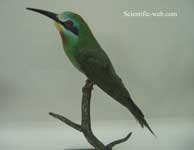The Blue-cheeked Bee-eater, Merops persicus, is a near passerine bird in the bee-eater family, Meropidae. It breeds in Morocco, Algeria, and subtropical Asia from eastern Turkey to Kazakhstan. It is strongly migratory, wintering in tropical Africa. This species occurs as a rare vagrant north of its breeding range. Description This species, like other bee-eaters, is a richly-coloured, slender bird. It is predominantly green; its face has blue sides with a black eye stripe, and a yellow and brown throat; the beak is black. It can reach a length of 24-26 cm, including the two elongated central tail feathers. Sexes are alike. This is a bird which breeds in sub-tropical semi-desert with a few trees, such as acacia. It winters in open woodland or grassland. As the name suggests, bee-eaters predominantly eat insects, especially bees, wasps and hornets, which are caught in the air by sorties from an open perch. However, this species probably takes more dragonflies than any other food item. Its preferred hunting perch is telephone wires if available. These bee-eaters are gregarious, nesting colonially in sandy banks. They make a relatively long tunnel in which the 4 to 8, spherical white eggs are laid. Both the male and the female take care of the eggs. These birds also feed and roost communally. The call sounds 'flatter' and less 'fluty' than the European Bee-eater. It has two subspecies * Merops persicus persicus - Asia This species is closely related to Blue-tailed Bee-eater, M. philippinus, and was formerly considered conspecific. References * BirdLife International (2004). Merops persicus. 2006 IUCN Red List of Threatened Species. IUCN 2006. Retrieved on 11 May 2006. Database entry includes justification for why this species is of least concern Retrieved from "http://en.wikipedia.org/"
 |
|
||||||||||||||||||||||||||||||||||
